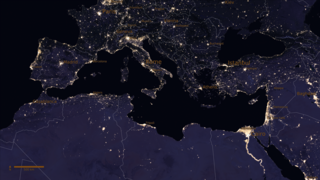Universe
ID: 30681
In 2004, the Hubble Ultra Deep Field (HUDF) provided a ground-breaking view of distant galaxies. In 2009, those data were augmented with new infrared observations to create the HUDF-IR. In 2012, the Hubble eXtreme Deep Field (HXDF) combined those images along with a complete census of archival datasets to see yet farther into the universe. The HXDF contains roughly 5,500 galaxies stretching over 13 billion light-years of space, and represents astronomy's deepest view into the cosmos.
This scientific visualization depicts a flight through the HXDF galaxies. Using measured and estimated distances for approximately 3,000 galaxies, astronomers and visualizers constructed a three-dimensional model of the galaxy distribution. The camera traverses through the thirteen-billion-light-year dataset and ends in blackness, not because more distant galaxies do not exist, but because such galaxies have not yet been observed. For cinematic reasons, the exceedingly vast distances in the 3D model have been significantly compressed.
Exploring the Hubble eXtreme Deep Field
This scientific visualization depicts a flight through the HXDF galaxies. Using measured and estimated distances for approximately 3,000 galaxies, astronomers and visualizers constructed a three-dimensional model of the galaxy distribution. The camera traverses through the thirteen-billion-light-year dataset and ends in blackness, not because more distant galaxies do not exist, but because such galaxies have not yet been observed. For cinematic reasons, the exceedingly vast distances in the 3D model have been significantly compressed.
Related
For More Information
Credits
Frank Summers (STScI): Project Support
Mark Malanoski (GST): Project Support
Lisa Frattare (STScI): Project Support
Tiffany Davis (STScI): Project Support
Zoltan Levay (STScI/Aura): Project Support
Greg Bacon (STScI/Aura): Project Support
Mark Malanoski (GST): Project Support
Lisa Frattare (STScI): Project Support
Tiffany Davis (STScI): Project Support
Zoltan Levay (STScI/Aura): Project Support
Greg Bacon (STScI/Aura): Project Support
Please give credit for this item to:
NASA, ESA, and F. Summers, L. Frattare, T. Davis, Z. Levay, and G. Bacon (Viz3D Team, STScI)
NASA, ESA, and F. Summers, L. Frattare, T. Davis, Z. Levay, and G. Bacon (Viz3D Team, STScI)
Short URL to share this page:
https://svs.gsfc.nasa.gov/30681
Mission:
Hubble
Keywords:
SVS >> Galaxy
SVS >> HDTV
SVS >> Hyperwall
SVS >> Hubble Space Telescope
SVS >> Astrophysics
SVS >> Cosmology
SVS >> Universe
SVS >> Space
SVS >> Redshift
NASA Science >> Universe
SVS >> Presentation
https://svs.gsfc.nasa.gov/30681
Mission:
Hubble
Keywords:
SVS >> Galaxy
SVS >> HDTV
SVS >> Hyperwall
SVS >> Hubble Space Telescope
SVS >> Astrophysics
SVS >> Cosmology
SVS >> Universe
SVS >> Space
SVS >> Redshift
NASA Science >> Universe
SVS >> Presentation












